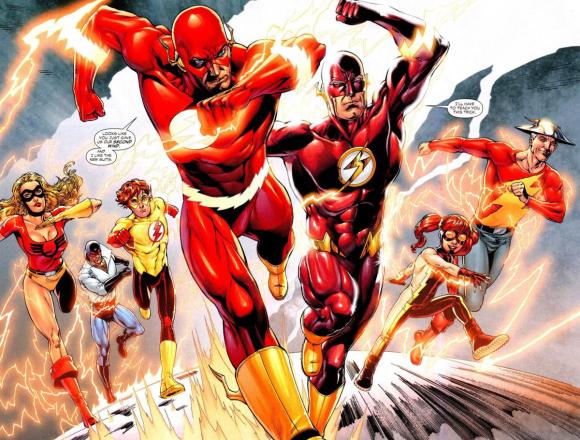Agent of S.T.Y.L.E. – The Flash Legacy Part 2!
Agent of S.T.Y.L.E.
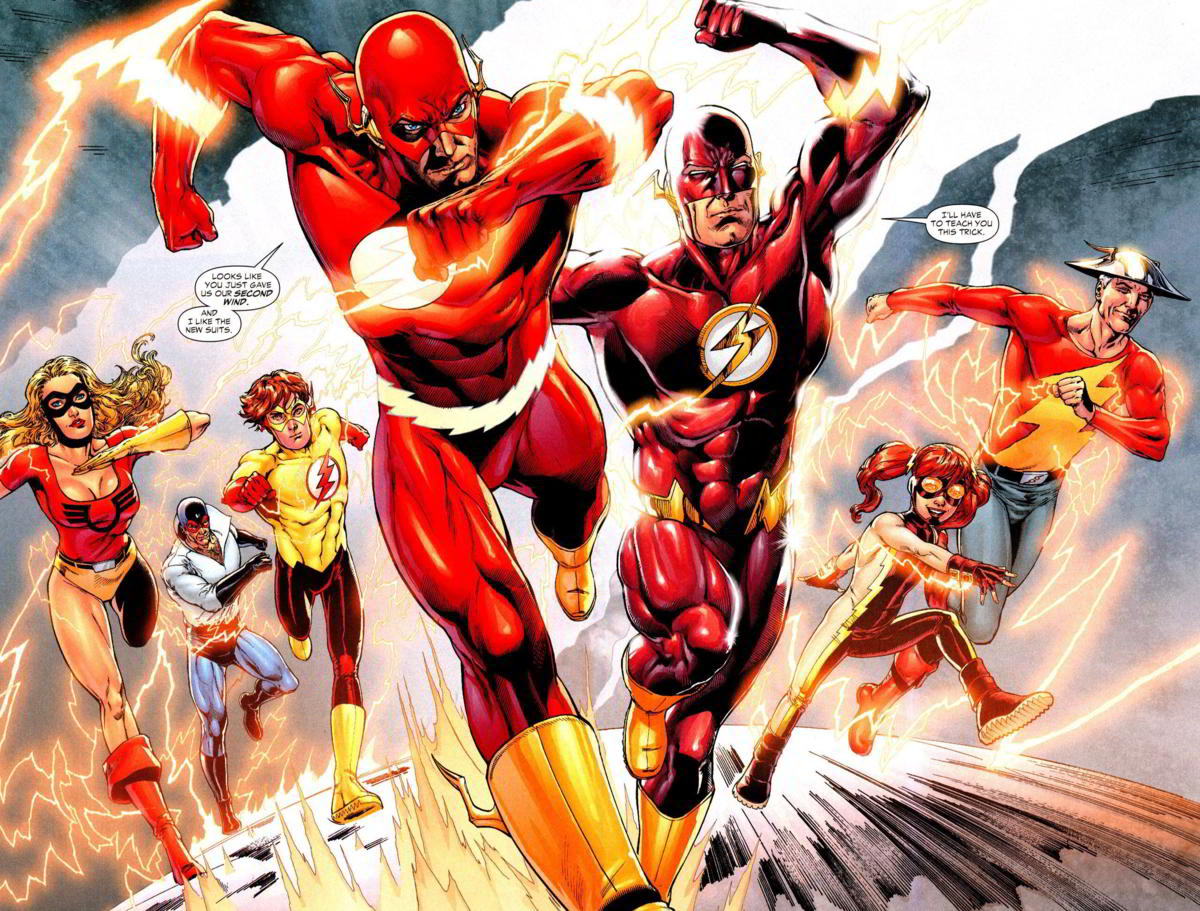
From 1956 until 1986, Barry Allen was the Flash, the fastest man alive. But he fell during Crisis on Infinite Earths, becoming one with the universe as he saved it from destruction. Wally West, formerly known as Kid Flash, then became the first superhero sidekick to fulfill the unspoken promise of one day succeeding the mentor. Over the years, Wally had some wardrobe changes and stepped aside from time to time while other Flashes stood in. Finally, Barry Allen returned and then… But maybe we’re getting ahead of ourselves. Let’s start with the first scarlet speedster of the DC Universe’s Post-Crisis era.
Be sure to check out Part 1 (which covers Jay Garrick and Barry Allen’s classic days) and Part 3 (which covers the New 52 versions).
FLASH: THE THIRD GENERATION
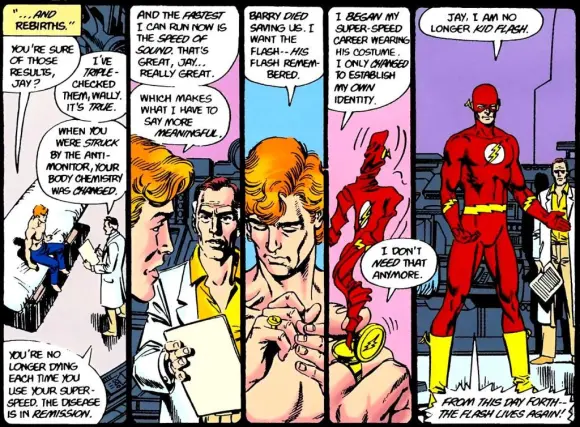
Following Barry’s death, Wallace “Wally” West took up the Flash mantle at the end of Crisis on Infinite Earths. Circumstances during that crossover led to him losing a lot of power, giving readers a much slower version of the Flash who couldn’t vibrate through matter, travel through time and space, or surpass the speed of sound. This, along with Wally now acting more like a jerk and requiring to eat constantly in order to fuel his speed, was DC’s way of making the Flash more grounded and relatable. Weirdly, DC immediately undermined this push to make Wally a more “realistic” and average guy by having him win the freaking lottery and get rich in the first issue of his new Flash series, which debuted in 1987.
In 1987, Wally’s new life involved gaining a new supporting cast, such as ally and later love interest Dr. Christina McGee. Tina was a scientist at S.T.A.R. (Scientific and Technology Advanced Research) Labs, which is basically an R&D organization in the DC Universe that specializes in meta-human powers and other weird sciences. I bring this up because S.T.A.R. Labs winds up recurring in Flash comics from this point on.
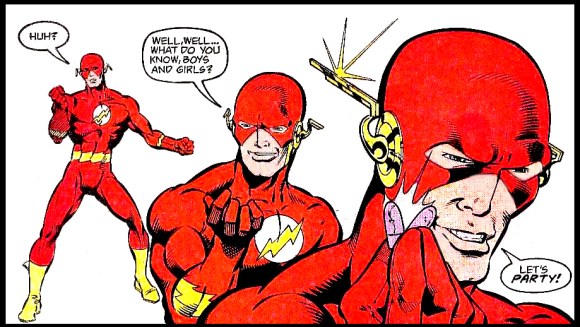
At first, Wally just wore Barry’s old suit. Sometimes, artist Jackson Butch Guice would draw the lightning emblem a little bit differently, similar to Barry’s if it were set on its side. Now, Wally wasn’t exactly a scientist so he wasn’t able to replicate the special shrinking/expanding fabric that allowed the costume to fit into a ring. But it turned out Barry left behind special equipment that created the costume automatically, so Wally used this to create a spare whenever he needed to.
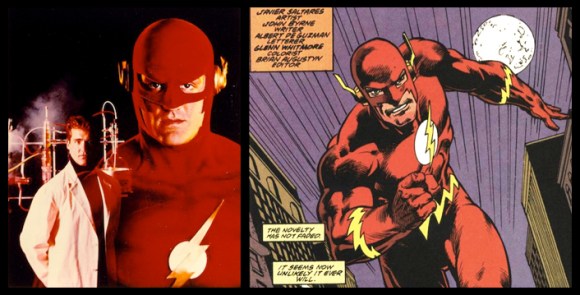
As Wally operated as the new Flash while trying to ignore everyone who compared him to his mentor, Barry Allen made it to live-action media. Starting in 1990 and lasting just a year, The Flash aired on CBS, starring John Wesley Shipp as the crimson comet. It was done a bit in the vein of the recently successful movie Batman, directed by Tim Burton. So despite the fact that Barry’s adventures had embraced high-concept science fiction, and comic book absurdity, this TV show tried to take everything more seriously. Barry initially wants his powers removed, seeing them as freakish traits. He goes to S.T.A.R. Labs and meets Dr. Christina McGee for help. In the comics, Barry’s body created a bio-electric aura that protected him and his clothing from friction. In the TV show, only his body was protected, so his clothes kept burning away. Tina fixed this by giving him a prototype pressure suit that happened to be colored red.
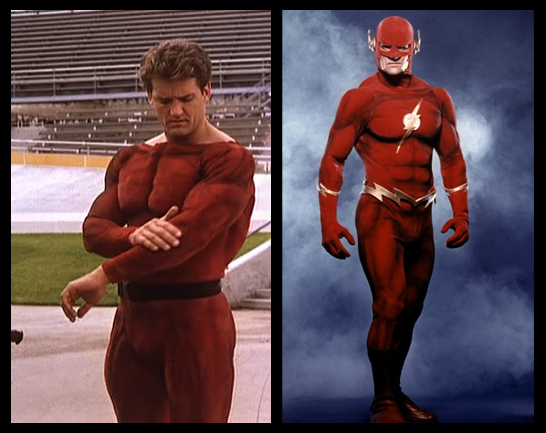
Other changes in the show included that Barry now had an older brother named Jay, a cop who was murdered by his old partner who was now a gang leader. Motivated initially by revenge, Barry added a mask and some lightning bolts to the pressure suit and became the Flash. So we were given grounded reasons why Barry would wear his costume, since live-action media often feels the need to do this even though we’re aware the movie features a superhero. But it ain’t a bad reason and although I was sad that the costume ring wasn’t used, it was rather cool to see how closely the TV show stayed to the comic book design. I don’t mind the lack of large yellow boots. Not sure about the cowl covering the nose, though. That’s a little too Batman for me. The Flash ain’t Batman. That belt is great though. A much sharper design than just a single lightning bolt across.
As the show went on, it stopped taking itself quite as seriously and it certainly had its fanbase. Mark Hamill even showed up as the costumed villain Trickster in two episodes. And one episode gave us a strange, blue-suited Barry clone who basically acted as the show’s version of the Reverse-Flash.
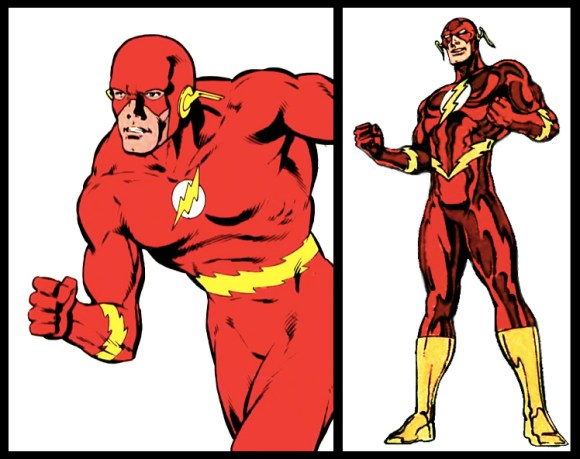
Back to the comics. Thanks to the villain Vandal Savage, Wally lost Barry’s costume-making equipment and nearly his own life too. So Wally got some new threads in Flash #50 (1991), written by William Messner-Loebs and penciled by Greg LaRocque. Fortunately, he had friends at S.T.A.R. Labs and hey, just like with the TV show, they made him a special suit. Constructed to help Wally utilize his speed in the best way possible, this suit was a darker shade of red, had a metallic finish, removed the wings from the boots, and added white reflective eye-lenses to the mask. The belt was also altered to mimic the cool one seen in the TV show.
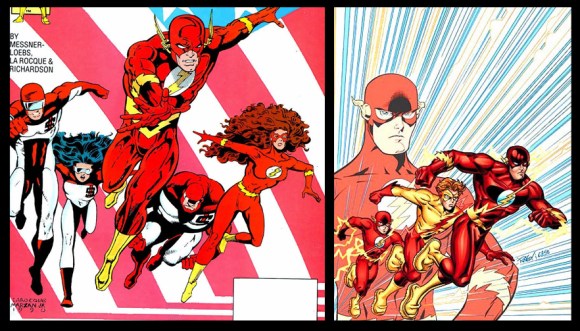
The changes to the boots and belt are tops. The mask having lenses would make more sense to disguise Wally’s identity, but since the Crisis he’d been operating publicly so they seem unnecessary. The metal reflective quality is neat in concept but a little much. It’s one of those design features that shouts, “Hey, dude! It’s the 90’s!” But all in all, this is a pretty good suit and it’s great to see that Wally no longer looked like a Barry clone. Later artist Mike Wieringo made another alteration when he simplified Wally’s cowl wings into triangles that implied simplified lightning bolts. Other artists followed this idea.
When Mark Waid came on as Flash writer, he got to work bringing Wally back into a more heroic personality and upping his power levels and sense of the fantastic. Waid had always been bothered by Jay Garrick’s origin and how there didn’t seem to be a link between several of the DC Universe’s speedsters (save for those who got their powers by mimicking the circumstances that endowed Barry Allen with speed). Waid revealed that each speedster didn’t just happen to have a near identical mutation. They were all, through different means, tapping into an extra-dimensional energy source that became known as the Speed Force. This was the true fuel for their speed, which is why the Flash didn’t immediately die of starvation after breaking the sound barrier. It also further explained what happened to Barry. His body didn’t just burn up because he ran faster than light. Breaking the lightspeed barrier for a speedster meant becoming energy and joining the Speed Force itself.
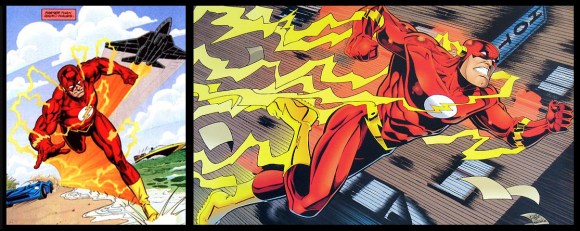
After the events of the 1994 crossover Zero Hour, Wally got a more direct connection to the Speed Force than any other speedster. This was explored in the story Terminal Velocity. As a result, he now trailed actual lightning bolts in his wake when he ran. Although this special effect was originally intended only for Wally, artists started adding it to all the speedsters whenever they ran and even gave it to Barry in flashback stories.
This was also used to finally explain just how the hell Wally West had suffered the same one-in-a-million lab accident that had given Barry his own speed powers. Mark Waid indicated that sometimes the Speed Force just reached out to people. Later still, Marv Wolfman wrote a novelization of Crisis on Infinite Earths that explained that Barry himself had caused Wally’s identical accident. When Barry was running his final race and shifting into a being of Speed Force energy, time and space had been warping around him and he inadvertently sent forth some of his own energy into the past, which became the lightning bolt that created Kid Flash. Thus, moments before his death, Barry Allen had unintentionally used time travel and paradox to ensure that he already had a trained apprentice ready to take his place. SCIENCE!

Writer Grant Morrison later used the Speed Force to give Wally another costume update. First, in the pages of JLA #8 (1997), Grant had Wally and his teammates imprisoned in dream worlds. In Wally’s dream, he was empowered by the New Gods (cosmic beings/aliens in the DC Universe) and got speed by tapping into the Speed Source (a combo of the Speed Force and the Source, which is what the New Gods basically call God/fate/the power behind reality). In this dream, Wally got speed powers by encasing himself in a frictionless suit of pure Speed Source energy that also gave him the appearance of Mercury (or Jay Garrick encased in the metal mercury).
In 1997, Grant Morrison temporarily took over writing duties on Flash and had Wally’s legs seriously injured. At first, Wally was taking it easy while Jay Garrick filled in for him, but then the hero came up with an idea. Remembering the dream world reality he’d experienced, he wondered if he couldn’t do a similar trick and pull enough Speed Force energy around him to create an exoskeleton that would restore his mobility. It worked and so for a couple of issues we had Wally sporting a suit of lightning energy that actually resembled his Kid Flash costume a little bit. Later still, this new Speed Force suit altered appearance and now looked like Wally’s previous red costume, except ditching the eye lenses and metallic sheen.
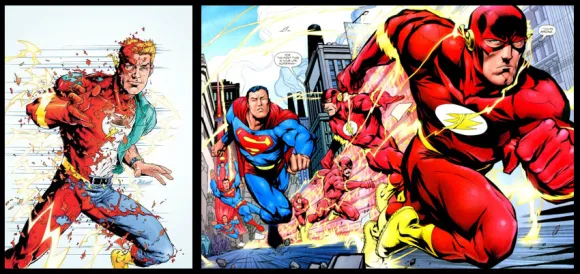
So basically, Wally finally got a suit that was the best of both Barry’s suit and his own 90’s suit. This might be my favorite take on the Flash. It goes back to that classic yet ultra-modern style, the open and visible eyes fit the character better, and it’s got that sharp belt. What’s more, we also got the costume ring back in a new way. Grant Morrison came up with the idea that Wally’s Speed Force suit could collapse into the shape of a golden ring. When Wally needed to go into action, the ring would expand around his body instantly, becoming the suit. That’s just cool, people.
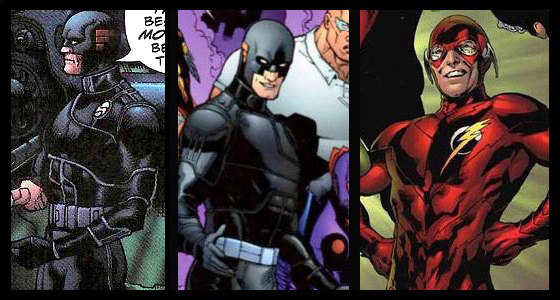
Oh, by the way, Wally occasionally rocked alternate outfits. There was the time in JLA when he split off into two entities, one who was pure Flash and one who was pure Wally West. The Flash version of this duo wound up altering his costume, adding lots of unnecessary seams and going for a more silver look. There was also the time that Wally served as a member of the black ops unit Justice League Elite. This wasn’t a great Flash costume, but then again he wasn’t really supposed to be identified as the Flash. It was basically just a black bodysuit with some small lines indicating cowl wings and a curved S emblem that could have been lightning if you squinted.
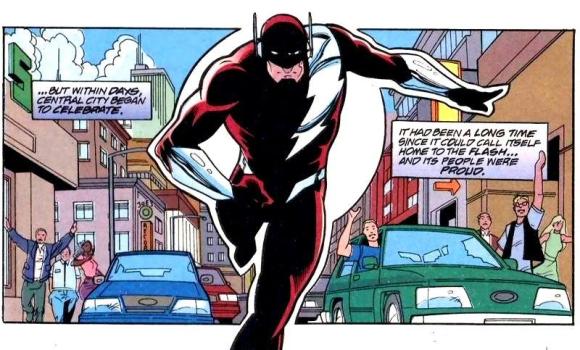
We could talk about the other Flashes Wally met from other timelines, but that would honestly take too long for this particular column. However, there is one guy we should talk about. Walter West, a Flash from a parallel Earth who stood in for Wally for a time. He had a lightning bolt scar and a black and silver suit. Not a bad design, but doesn’t really work for me as Flash. It’s hard to beat that classic idea that Barry Allen started.
HEY, LOOK! WOMEN!
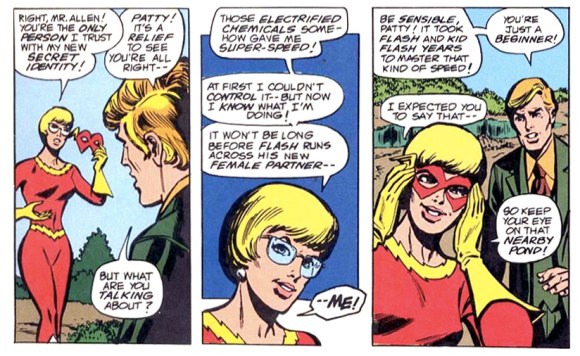
Now let’s take a step back. A few times now and then, there were ladies who took on a Flash identity. The first turned out to be a dream/hallucination. In DC Special Series #1 (1977), we met Barry Allen’s colleague Patty Spivot. As she stood before a rack of chemicals, lightning struck and boom, she wound up with powers similar to the Flash. So she made a … well, honestly, a pretty lame costume … and she decided she’d call herself Ms. Flash. But Barry warned her that he didn’t think this was a good idea and then it turned out he was right because Patty’s powers were unstable. Patty realized, oops, I’m not good enough to be a superhero.

The story concluded by telling us that none of this had actually happened but was a scenario that Barry imagined during the split second between when the lightning bolt crashed through the window and before it would have imbued Patty with powers. Fearing his imaginary scenario, Barry got Patty out of the way and prevented any chance of her getting powers, unstable or otherwise. If you find it a bit sexist that Barry had no problem recruiting and trusting a 10-year-old boy with super-speed but panicked at what might happen if an adult woman had such power … you have a point. In recent years, Patty Spivot returned to comics as a CSI for the Central City PD and a love interest for Barry Allen.
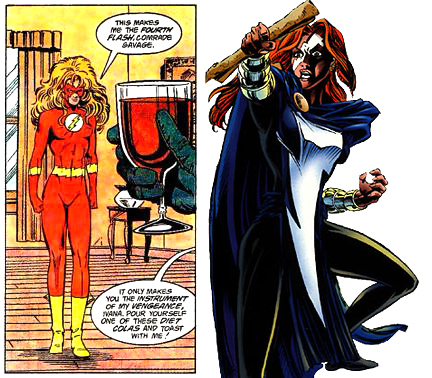
Soon after Wally became the Flash, he encountered Blue Trinity, three members of a USSR experiment to duplicate the Flash’s abilities. The members of Blue Trinity weren’t all that stable and were later succeeded by the more heroic and affable Red Trinity group. One member of Blue Trinity was Ivana Christina Borodin Molotova (often simply called Christina Molotova). Christina constantly looked for someone to follow. She later fell in with Vandal Savage and called herself Lady Savage. Then, in Flash volume 2 #50 (the same issue where Wally got his metallic suit), Vandal Savage gave her one of Wally’s suits. She cut up the cowl and was now Lady Flash. Initially she fought him, then fell for him and stuck around for a bit before leaving to find a new life. She showed up again later as the mistress and warrior of the evil speedster Savitar under the name Lady Savitar.
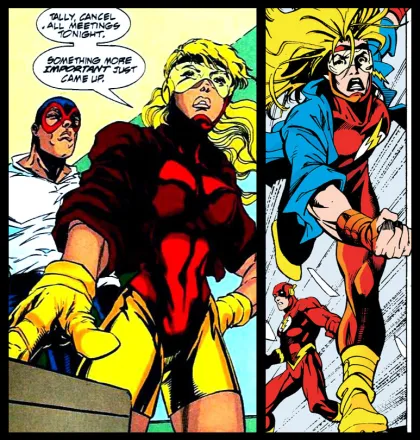
But not all female versions of the Flash were dangerous or had identity issues. And I don’t just mean those ladies who inhabited parallel realities and possible futures. In the mainstream DC Universe, during Terminal Velocity, Wally believed he might very soon die. He had hoped that the young hero Impulse would take his place, but feared that the kid didn’t take things seriously. To get Impulse to step up, Wally said that his successor would be Jesse Chambers AKA Jesse Quick, daughter of the WWII heroes Johnny Quick and Liberty Belle. Like her father, Jesse accessed Speed Force energy by focusing on a mathematical formula as she recited it out loud: 3×2(9yz)4a. She was more than ready to become the new Flash, fastest hero alive!
Of course, Wally survived the events of Terminal Velocity so there was no need for Jesse to take up the mantle. When she realized he’d never intended her to do so anyway and had manipulated her for Impulse’s benefit, she tore him a new one and it was quite a while before she was friendly towards the guy. For his own part, Wally admitted he had been wrong to treat her in such a way.
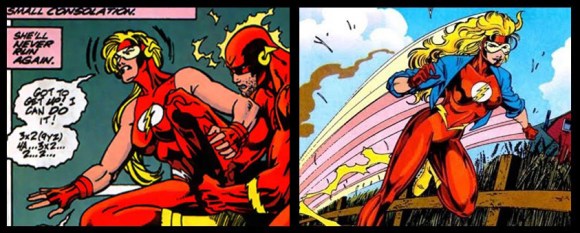
Jesse had been, for a while, wearing a costume that was basically a jacket over an exercise outfit. She took that sensibility with her new Flash costume. It’s not a bad look at all. Keeps the Flash sensibility, while making it her own with the goggles, short sleeves and buckled boots and gloves. The blue jacket is a nice nod to both her first costume and Jay Garrick’s use of the color blue. But I’m not entirely down with speedsters having jackets or capes. I keep thinking it’s just going to fly off when they get past the speed of sound or catch on something when they’re rounding a corner.
MORE FLASH FAMILY!
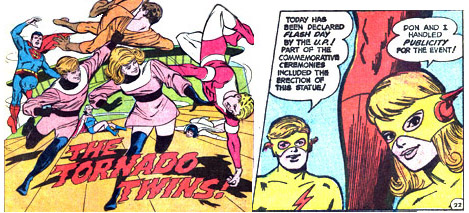
Let’s backtrack. In the 1960s, the 30th century team known as the Legion of Super-Heroes met the Tornado Twins, a couple of fun speedster siblings. They were Don and Dawn Allen and explained that they were direct descendants of Barry Allen. They organized publicity for the holiday known as Flash Day and even once dressed up in Kid Flash costumes.
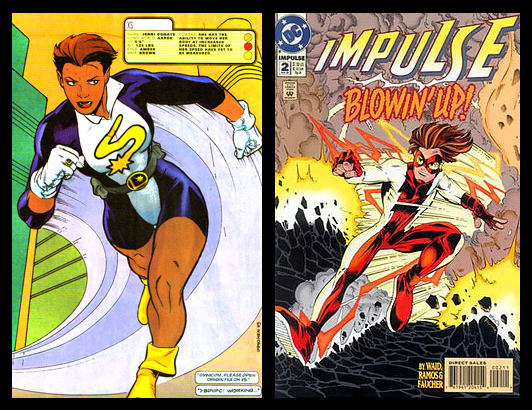
Of course, just before the Crisis, we learned that Iris Allen was living in the 30th century and apparently stayed there after Barry’s death. So Mark Waid revealed that Don and Dawn weren’t Barry’s descendants, they were straight up his and Iris’s kids. And it turned out they had kids themselves who also had super-speed. Dawn’s daughter Jenni Ognats was introduced in Legionnaires #0 (1994) and became a member of the Legion of Superheroes under the name XS. She just wore a standard Legion uniform with an S on it that ended in a starburst. Not a bad design, but seems like it could be stronger. Meanwhile, Don had a son Bart Allen, a yellow-eyed boy whose super-speed caused him to age rapidly. To make sure his mind kept up with his body, he was raised in virtual reality simulations. Finally, when he was physically reaching adolescence, Iris took Bart Allen into the present day to see if Wally had any idea how to help the kid. This led to his first appearance in Flash #91 (1994), just before the crossover Zero Hour.
Wally helped Bart adjust to his super-speed, causing his aging to shift to a normal rate. But a life spent living in video games meant that Bart had a warped sense of risk and danger. He basically acted on all his impulses. So he took the name Impulse, later claiming that he had heard Batman call him this during Zero Hour and had not understood it wasn’t a compliment. Bart had a costume already, a red and white lightning decorated suit he had worn in the 30th century. After seeing several superheroes, he assumed that there was a law in the 20th century that required people with powers to wear a mask, so he got one himself that also had goggle lenses. After Terminal Velocity, Impulse went off to be mentored by wise speedster Max Mercury and had a lot of hilarious adventures. Just as Jay, Barry and Wally had all been founders of teams, Bart Allen followed the tradition by becoming a founding member of Young Justice alongside Superboy (Kon-El) and Robin III (Tim Drake).
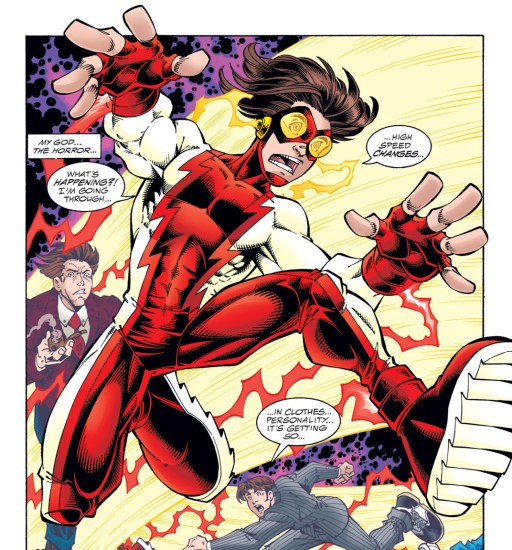
Impulse’s suit is pretty slick. He’s not Kid Flash but you can still see the link to the Flash legacy. But he definitely stands on his own and really, even with a bio-electric aura, it’s curious that more speedsters don’t wear goggles just to keep the wind and bugs out of their eyes. Do bio-electric auras zap bugs? Something to consider. Impulse’s initial adventures were illustrated by Humberto Ramos, who gave him fairly large feet. Throughout Impulse’s adventures afterward, it became a running gag to have other characters remark on the character’s large feet, even when other artists were handling him.
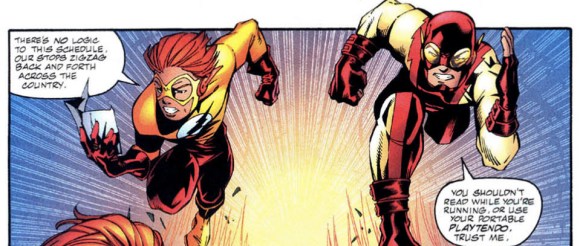
In the crossover Sins of Youth, Bart wound up temporarily aged to adulthood and Wally was reverted back to adolescence. Magical forces altered their costumes in the process. Bart now had a full cowl covering his hair, automatically indicating a more serious personality. Wally got his old Kid Flash suit again, except now the boots were wing-less and the shirt had a white disc behind the lightning bolt, strengthening the connection with the Flash identity. A very nice touch and one that Bart wound up copying.
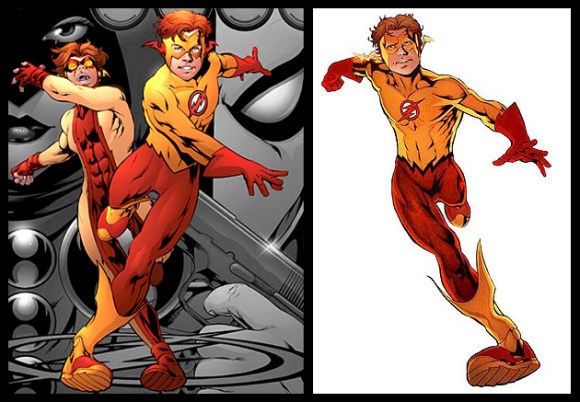
When Young Justice was cancelled, its members wound up joining with other heroes to form a new version of the Teen Titans. Tired of being considered a joke by others, Bart Allen decided to step up his game. He became the new Kid Flash, taking the Sins of Youth suit but giving the boots, belt and gloves a lightning bolt edge. The boots also looked more heavy duty now, which makes sense because hey, if you didn’t know, Bart runs A LOT.
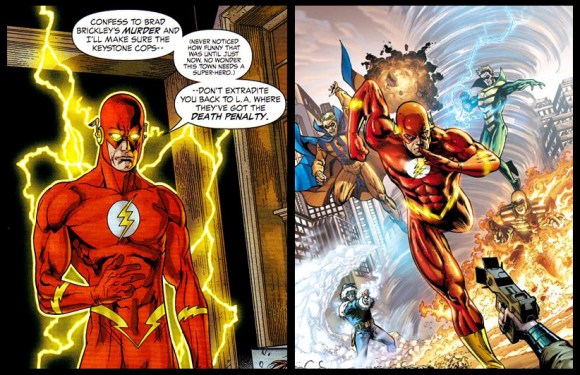
Now, the Flash books went through a lot of changes after the 2006 crossover Infinite Crisis. Wally wound up leaving reality, alongside his wife Linda Park and their newborn twins. Bart was aged up to adulthood and took on the mantle of the Flash, using the same basic design Wally had been using since adopting a Speed Force suit. The only real difference was that Bart’s yellow eyes would glow sometimes when he was using his powers.
I’m not gonna lie, I don’t like to talk about this time a lot. As Bart’s series Flash: The Fastest Man Alive continued, response wasn’t great and it became pretty clear that DC didn’t know what to do with him. So the solution became to kill him in action in 2007 during a battle with the Rogues and his evil double Inertia. Like his grandfather, Bart sacrificed himself to save others. Wally returned to the DC Universe at about the same time, now with his kids a little older and both showing super-powers. Geoff Johns then brought back Bart and made him young again in Final Crisis: Legion of 3 Worlds, a tie-in miniseries to the 2008 crossover Final Crisis. That same crossover brought back Barry Allen from the Speed Force.
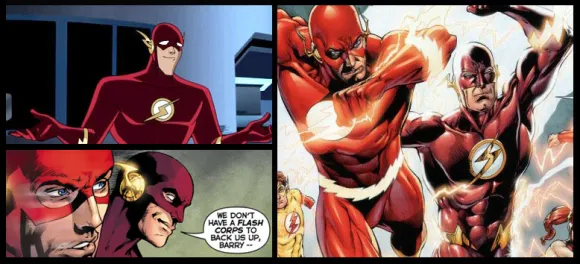
This all led into the mini-series Flash: Rebirth where most of the speedsters got a redesign. With Wally and Barry now both alive and operating, it became necessary to give Wally a distinctive look. His new post-Rebirth costume brought back the white eye lenses and adopted the slightly different lightning bolt symbol seen in the recent cartoon series Justice League and Justice League Unlimited (2001- 2006). These cartoons had increased Wally’s popularity, so referencing them certainly made sense. His color was also deepened to a maroon rather than a bright red, with raised metallic gold on the emblem and lightning trim. What’s more, his cowl was altered to be a more standard superhero cowl, with no lightning points. The nose was also covered now, similar to John Wesley Shipp’s suit on television.
It’s a pretty sharp design and it’s great that Wally was able to maintain looking like the Flash. I think the only alternative would have been to give him a more Kid Flash looking outfit or cowl. But the fact was, for over two decades at that point and as far as many cartoon viewers were concerned, Wally was the Flash, not Kid Flash and not Alternate Flash.
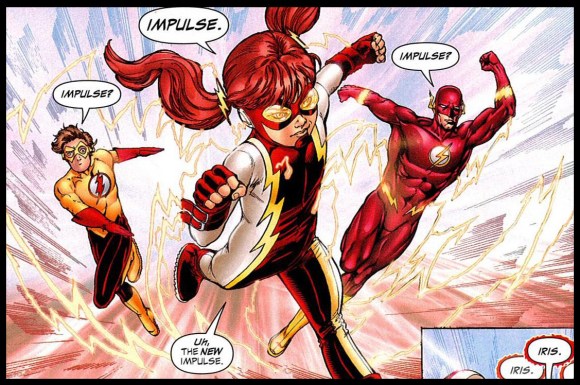
The same mini-series gave Bart a simplified version of his boots and gloves. Wally’s daughter Iris became the new Impulse. And holy crap, she looked adorable. She had gold trim around her red lightning bolt, which is very nice. And look at those cute lightning bolt hair clips. Seriously, she should’ve gotten her own series right then and there, maybe with Bart as a would-be-older-brother. Impulse and Kid Flash. It could’ve been great.
Barry, naturally, kept his classic suit. He started off a new Flash series and then … well, then DC decided to screw it all and all the plans certain writers had been making for certain characters. In 2011, the crossover Flashpoint featured Barry Allen in a new timeline. He restored space and time as best he could, but changes happened anyway, leading to a brand new reality. All the DC books cancelled and were replaced with 52 brand new titles featuring an altered version of the universe. We’ll discuss the New 52 in the next column.
Be sure to check out Part 1 (which covers Jay Garrick and Barry Allen’s classic days) and Part 3 (which covers the New 52 versions).
Alan Sizzler Kistler (@SizzlerKistler) is an actor and writer who loves the legacy of the Flash heroes. He is the author of Doctor Who: A History.
Have a tip we should know? [email protected]
